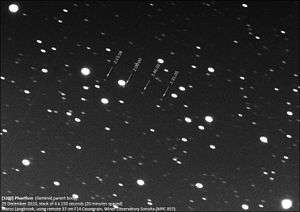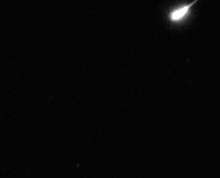Geminids
The Geminids are a prolific meteor shower caused by the object 3200 Phaethon,[4] which is thought to be a Palladian asteroid[5] with a "rock comet" orbit.[6] This would make the Geminids, together with the Quadrantids, the only major meteor showers not originating from a comet. The meteors from this shower are slow moving, can be seen in December and usually peak around December 6–14, with the date of highest intensity being the morning of December 14. The shower is thought to be intensifying every year and recent showers have seen 120–160 meteors per hour under optimal conditions, generally around 02:00 to 03:00 local time. Geminids were first observed in 1862,[1] much more recently than other showers such as the Perseids (36 AD) and Leonids (902 AD).
| Geminids (GEM) | |
|---|---|
 The Geminids meteor shower as seen from the Northern Hemisphere, in December 2013 | |
| Pronunciation | ge•minids |
| Discovery date | 1862[1] |
| Radiant | |
| Constellation | Gemini (near Castor) |
| Right ascension | 07h 28m[2] |
| Declination | +32°[2] |
| Properties | |
| Occurs during | December 4 – December 17[2] |
| Date of peak | December 14[2] |
| Velocity | 35[3] km/s |
| Zenithal hourly rate | 120[2] |
Radiant


The meteors in this shower appear to come from the radiant in the constellation Gemini (hence the shower's name). However, they can appear almost anywhere in the night sky, and often appear yellowish in hue. Well north of the equator, the radiant rises about sunset, reaching a usable elevation from the local evening hours onwards. In the southern hemisphere, the radiant appears only around local midnight or so. Observers in the northern hemisphere will see higher Geminid rates as the radiant is higher in the sky.[7] The meteors travel at medium speed in relation to other showers, at about 22 miles per second (35 km/s), making them fairly easy to spot. The Geminids are now considered by many to be the most consistent and active annual shower. Geminids disintegrate while at heights above 24 miles (39 km).[8]

| Year | Active | Peak of shower | ZHRmax | Lunar phase |
|---|---|---|---|---|
| 2006 | December 7–17 | December 14 | 115[9] | 33% waning crescent |
| 2007 | December 15 | 122[10] | 28% waxing crescent | |
| 2008 | December 14 | 139[11] | 96% full moon | |
| 2009 | December 13 | 120[12] | 10% new moon | |
| 2010 | December 7–17 | December 14 | 127[13] | 57% first quarter |
| 2011 | December 14 | 198[14] | 86% waning gibbous | |
| 2012 | December 4–17[3] | December 13–14[3] | 109[15] | 1% new moon |
| 2013 | December 4–17[16] | December 14[16] | 134[17] | 91% full moon |
| 2014 | December 4–17[18] | December 14[18] | 253[19] | 50% Last quarter |
| 2018 | - | December 14 | - | - |
| 2019 | December 7–17 | December 14 | - | - |
See also
References
- Gary W. Kronk. "Observing the Geminids". Meteor Showers Online. Archived from the original on 2008-05-17. Retrieved 2012-11-14.
- Moore, Patrick; Rees, Robin (2011), Patrick Moore's Data Book of Astronomy (2nd ed.), Cambridge University Press, p. 275, ISBN 978-0-521-89935-2.
- "IMO Meteor Shower Calendar 2012: Geminids (GEM)". International Meteor Organization. Retrieved 2012-12-13.
- Brian G. Marsden (1983-10-25). "IAUC 3881: 1983 TB and the Geminid Meteors; 1983 SA; KR Aur (Circular No. 3881)". Central Bureau for Astronomical Telegrams. Archived from the original on 2012-05-01. Retrieved 2009-05-18.
- Victoria Jaggard (2010-10-12). "Exploding Clays Drive Geminids Sky Show?". National Geographic Society. Archived from the original on 2012-12-13. Retrieved 2010-10-18.
- Jewitt, David; Li, Jing (2010). "Activity in Geminid Parent (3200) Phaethon". The Astronomical Journal. 140 (5): 1519–1527. arXiv:1009.2710. Bibcode:2010AJ....140.1519J. doi:10.1088/0004-6256/140/5/1519.
- "Radiant (Northern vs Southern)". NASA Meteor Watch on Facebook. 2012-12-12. Retrieved 2012-12-14.
- "NASA All Sky Fireball Network: Geminid End Heights". NASA Meteor Watch on Facebook. 2012-12-11. Retrieved 2012-12-11.
- "Geminids 2006: visual data quicklook". International Meteor Organization. 2007-04-25. Archived from the original on 2012-12-24. Retrieved 2012-12-13.
- "Geminids 2007: visual data quicklook". International Meteor Organization. 2008-08-10. Archived from the original on 2012-12-17. Retrieved 2012-12-13.
- "Geminids 2008: visual data quicklook". International Meteor Organization. 2009-01-02. Archived from the original on 2013-02-02. Retrieved 2012-12-13.
- "Geminids 2009: visual data quicklook". International Meteor Organization. 2010-04-19. Archived from the original on 2012-12-17. Retrieved 2012-12-13.
- "Geminids 2010: visual data quicklook". International Meteor Organization. 2012-09-19. Archived from the original on 2012-11-03. Retrieved 2012-12-13.
- "Geminids 2011: visual data quicklook". International Meteor Organization. 2012-01-18. Archived from the original on 2012-12-28. Retrieved 2012-12-13.
- "Geminids 2012: visual data quicklook". International Meteor Organization. 2012-12-21. Archived from the original on 2013-09-17. Retrieved 2013-10-11.
- "IMO Meteor Shower Calendar 2013: Geminids (GEM)". International Meteor Organization. Retrieved 2013-10-11.
- "Geminids 2013: visual data quicklook". International Meteor Organization. 2013-12-21. Archived from the original on 2013-12-16. Retrieved 2014-01-06.
- "IMO Meteor Shower Calendar 2014 - Geminids". International Meteor Organization. Archived from the original on 10 September 2015. Retrieved 4 September 2015.
- "Geminids 2014: visual data quicklook". International Meteor Organization. Archived from the original on 24 September 2015. Retrieved 4 September 2015.
External links
| Wikimedia Commons has media related to Geminids. |
- Viewing details for the 2015 Geminids Meteor Shower
- Viewing information for the 2015 Geminids meteor shower
- NASA Meteor Watch 2012:
- Allsky cameras observed 328 bright Geminids - notice how similar they are to the orbit of the asteroid 3200 Phaethon (purple orbit)
- Composite view of meteors detected in the skies over Marshall Space Flight Center (MSFC)
- Spectacular Geminid, brighter than the Full Moon (video 2012-Dec-14 07:28 UT)
- Meteoroid Environment Office: 53 meteor orbits last night of which 18 were Geminids
- 2004 Geminids
- 2006 Geminids
- ShadowandSubstance.com: Geminids animated for 2010
- "Weird Geminids," NASA, 7 December 2001
- Google group search for Geminids, sorted by date
- Amateur observations of the Geminids
- Triangulation of a Geminid Meteor by Crayford Manor House AS
- ScienceCasts: Rock Comet Meteor Shower (Science@NASA YouTube channel : Nov 29, 2012)
- Geminids at Constellation Guide
- NASA Astronomy Picture of the Day: When Gemini Send Stars to Paranal (15 December 2012)